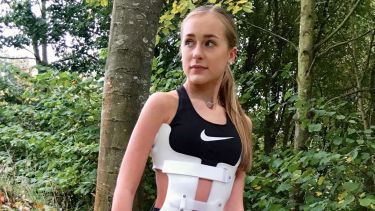- University of Sheffield and Sheffield Children’s Hospital will compare two braces used to treat children with scoliosis
- The study will assess the use of ‘full-time braces’, which have to be worn 20 hours a day, and night-time braces
- Scoliosis is a condition in which the spine curves to the side and commonly develops in children between 10 and 15
The University of Sheffield and Sheffield Children’s Hospital are leading a new study to compare two back braces for children with adolescent idiopathic scoliosis (AIS).
Scoliosis is a condition where the spine curves to the side and twists. It can affect people of any age, but most commonly develops in children while they are growing between the ages of 10 and 15 years.
If the curve becomes too large, its appearance can cause problems with body image and self-esteem, and may lead to back pain and problems with the heart and lungs in adulthood. To stop the curve getting any bigger and to reduce the need for surgery, a back brace may be prescribed.
The most common type of brace is known as a ‘full-time brace’, which holds the spine in position to prevent the curve from worsening. This brace is usually worn for 20 hours a day. An alternative is a ‘night-time brace’, which is only worn in bed at night and can provide a stronger force to push the curve straighter.
The Bracing Adolescent Idiopathic Scoliosis (BASIS) study will investigate whether the night-time brace is as good as the currently used full-time brace for treating young people with scoliosis. Funded by the National Institute for Health Research (the nation’s largest funder of healthcare research), it will be coordinated by the Clinical Trials Research Unit at the University of Sheffield.
Lizzie Swaby, Study Manager from the University of Sheffield’s School of Health and Related Research (ScHARR), said: “I'm looking forward to working on this study. If the night-time braces are shown to be as effective as the current full-time braces, this will provide more options for patients in future treatment of scoliosis, particularly as some patients prefer the idea of a night-time brace.”
Mr Ashley Cole, Consultant Spinal Surgeon at Sheffield Children’s Hospital and Chief Investigator for the BASIS study, said: “Braces can interfere with day-time activities and be uncomfortable for young people. In the UK we currently use full-time braces to treat scoliosis, but lots of families tell us they would prefer to use a night-time brace. This study will help us to find out which brace is best - for both curve progression and quality of life - and whether we can start routinely offering the night-time brace to patients.”
The study needs 780 patients from 19 UK paediatric spinal centres, enrolled over four years, and started in November 2021. Some families will also be invited to take part in an interview about the communication they have received as part of the study.
The type of back brace each participant receives will be chosen at random, and they will continue to wear it until they have finished growing or need to have surgery. During the study, participants will be sent questionnaires and attend hospital for back x-rays.
Two patient groups and a survey of Scoliosis Association UK (SAUK) members have helped with designing the study to ensure it is appropriate for young people and their families.
Charlotte, 18, is a patient representative on the oversight committee for the BASIS study. She wore a brace from the age of nine to 15 and was treated at the Royal National Orthopaedic Hospital.
Charlotte said: "I've really enjoyed my involvement with the BASIS team so far. As someone who's previously worn a back brace for over five years, it's been really reassuring to see how much care and thought has gone into this study and how it will impact the lives of brace-wearers.
“Personally, I found wearing a back brace to be an overall positive experience but I know this is not the case for everyone. Many aspects of wearing a brace for 20 hours a day can be painful, like the overheating in summer or the discomfort of growing out of your brace. Seeing the BASIS team's research centre around how to make brace-wearing better for patients has been really encouraging."
Olivia, 16, was a patient at Sheffield Children’s Hospital after receiving a diagnosis of scoliosis and was treated with a brace. Olivia isn’t part of the BASIS trial, but said: “This study will be really good to help future patients like me get the best treatment they can, I’m really grateful for the care I got at Sheffield Children’s and the brace helped me a lot, this study will make sure we’re giving the best care to future patients.”
Additional information
- This study is funded by the National Institute for Health Research (NIHR) Health Technology Assessment programme (NIHR131081). The views expressed are those of the author(s) and not necessarily those of the NIHR or the Department of Health and Social Care.
- Sheffield Children's Hospital
Contact
For further information please contact:

